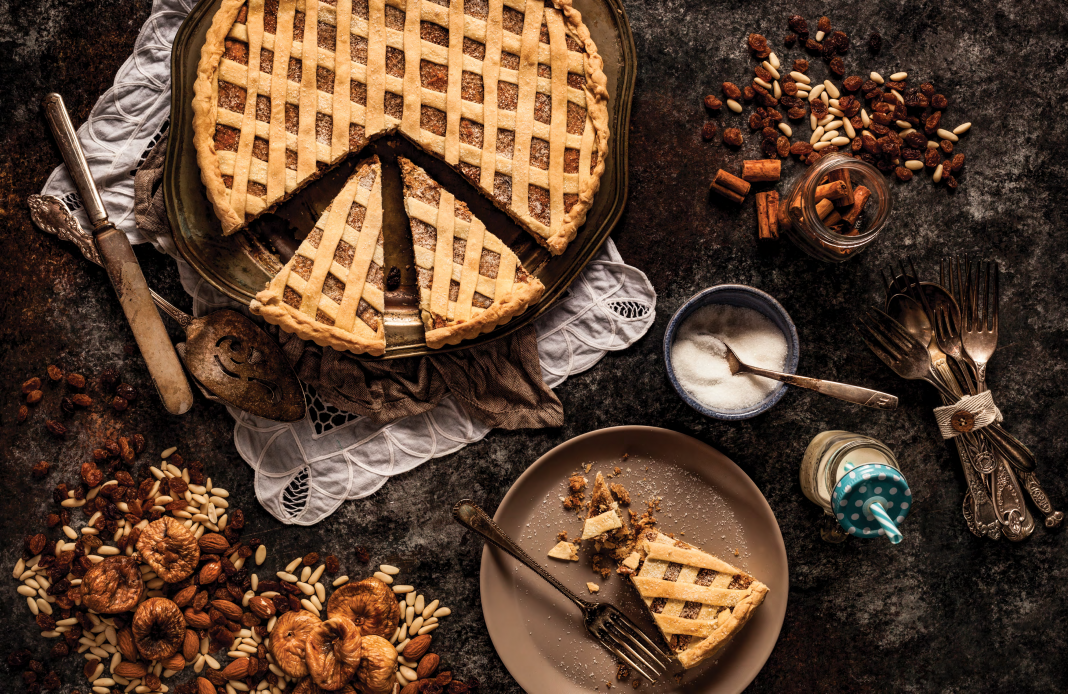Medieval cooking is rife with fragrant, exotic spices, which became more and more accessible during the times of the Crusades and the international trade they ushered in. All those spices conveniently camouflaged unsavory flavors and odors too, which was a boon to medieval kitchens. The three recipes here make abundant use of spices beloved in the Middle Ages—especially cinnamon, which was a status symbol for those European nobles rich enough to snag it from Arab traders. Plus, who doesn’t love cinnamon and clove during the holidays?
Recipe from the Medieval Issue #41
Print // Digital
Served as a dessert or an afternoon snack, this rich, spice-laden tart is perfect for the holidays. The pureed chickpeas make a nice paste for the filling, adding texture more than flavor, and the rosewater makes it extra fragrant and festive.
For the crust:
2 cups flour
1 stick and 1 tbsp. unsalted butter, chilled
⅓ cup and 2 tbsp. ice water
pinch of salt
To finish:
1 tbsp. rosewater
1 tbsp. sugar
For the filling:
2 cups cooked chickpeas
1 egg
⅔ cup sugar
4 dried figs
1/2 cup raisins
1/2 cup almonds
⅛ cup pine nuts
2 tbsp. rosewater
3 tsp. ground cinnamon
2 tsp. ground ginger
pinch of salt
In the bowl of a food processor, combine flour and salt. Cut butter in small chunks, add it to the mixture and process until it resembles coarse meal, 8 to 10 seconds.
With machine running, add water in a slow, steady stream. Pulse until dough holds together without being sticky; be careful not to process more than 30 seconds. If it is still crumbly, add more water, a few drops at a time.
Shape dough into a ball, flatten it out to a disk and wrap in plastic. Transfer to the refrigerator and chill at least 45 minutes.
Preheat the oven to 350°F.
Meanwhile prepare the filling: Place cooked chickpeas in a food processor and puree them. Add sugar, egg, spices, salt, rosewater, and coarsely chopped dried fruit. Mix well and set aside.
Remove the dough from there frigerator and place on a lightly floured surface. Let it sit for 5 to 10 minutes so that it becomes easier to roll it out. Using about two-thirds of it, roll it out to a circle about ⅛ inch thick.
Place it onto the lightly greased tart pan, pressing gently to fit, then scoop the filling into the tart shell and even it out using a spoon.
Roll out the remaining dough, and using a pastry wheel or sharp knife cut it into 16 to 20 strips. Lay half of the strips across the filling and arrange the other half diagonally across the first ones to form a lattice. Trim edges of all strips to fit into the pan.
Bake the tart for about 45 minutes, then sprinkle the top with additional sugar and drops of rosewater, then finish baking for another 5 to 10 minutes, until the crust is golden brown. Let the tart sit in the pan on a rack for 10 minutes, then remove it and cool completely.


































What do you think I can substitute for the egg to make it vegan? Do you think applesauce would work?
Hi,
Do you have an original medieval source for this recipe? I’d love to play with it for a medieval potluck dish.
Also, given the price of spices in the middle ages, they weren’t really covering up anything unpleasant. They had perfectly good other aromatics for those sorts of purposes. It would be like using gold leaf on a Twinkie.